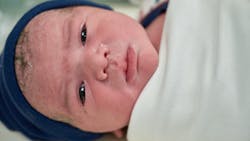2020 U.S. birth rates fall to lowest on record
The U.S. birth rate in 2020 dropped to about 56 births per 1,000 women of child-bearing age, the lowest rate on record, according to a National Vital Statistics System Rapid Release report from the National Center for Health Statistics (NCHS) and released by the Centers for Disease Control and Prevention (CDC). The rate is half of what it was in the early 1960s.
Other highlights from the CDC report include:
- About 3.6 million babies were born in the U.S. last year, down from about 3.75 million in 2019. When births were booming in 2007, the U.S. recorded 4.3 million births.
- The birth rate for 15- to 19-year-olds dropped 8% from 2019. It's fallen almost every year since 1991.
- Birth rates fell 8% for Asian American women; 3% for Hispanic women; 4% for Black and white women; and 6% for moms who were American Indians or Alaska Natives.
- The cesarean delivery rate rose, slightly, to about 32%. It had generally been declining since 2009.
The provisional number of births for the U.S. in 2020 was 3,605,201, down 4% from the number in 2019. This is the sixth consecutive year that the number of births has declined after an increase in 2014, down an average of 2% per year, and the lowest number of births since 1979.
From 2019 to 2020, the provisional number of births declined 3% for Hispanic women, 4% for non-Hispanic white and non-Hispanic black women, 6% for non-Hispanic AIAN women, and 8% for non-Hispanic Asian women. The 2% decline in the number of births for non-Hispanic NHOPI women was not significant.
The provisional general fertility rate (GFR) for the U.S. in 2020 was 55.8 births per 1,000 women aged 15 to 44, down 4% from the rate in 2019, another record low for the nation. From 2014 to 2020, the GFR declined by an average of 2% per year. GFRs declined for each of the race and Hispanic-origin groups from 2019 to 2020, down 3% for non-Hispanic NHOPI women; 4% for non-Hispanic white, non-Hispanic black, and Hispanic women; 7% for non-Hispanic AIAN women; and 9% for non-Hispanic Asian women.
The early preterm rate declined from 2.77% to 2.69%, the lowest level reported since at least 2007. The late preterm rate declined from 7.46% to 7.39%.
The preterm birth rate declined 3% among births to non-Hispanic Asian women (8.72% to 8.50%), 2% among non-Hispanic white women (9.26% to 9.10%), and 1% among Hispanic women (9.97% to 9.83%) from 2019 to 2020; changes for births to non-Hispanic AIAN (11.59% to 11.57%), non-Hispanic black (14.39% to 14.35%), and non-Hispanic NHOPI (11.15% to 11.98%) women were not significant.
Late preterm births declined among non-Hispanic Asian (6.59% to 6.42%) and non-Hispanic white mothers (6.99% to 6.90%), but changes for non-Hispanic black (9.45% to 9.54%), non-Hispanic AIAN (8.69% to 8.55%), non-Hispanic NHOPI (8.25% to 8.93%), and Hispanic (7.36% to 7.32%) mothers were not significant. Early preterm births were down for the three largest race and Hispanic origin groups (non-Hispanic white, non-Hispanic black, and Hispanic), but were not significantly changed for the others.
